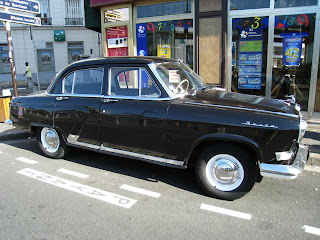The first Volga model was originally developed as a replacement for the very successful GAZ-M20 Pobeda mid-size car which was produced since 1946. However despite its revolutionary design in form of chassis and body styling, the rapid evolution of the latter in the 1950s already caused Soviet designers in 1951 to put forward a project for its eventual replacement. In 1952 two parallel projects were set up by GAZ: Zvezda ("Star"), which was a futuristic fastback with panoramic windows and large tailfins, and Volga with more conventional styling, which was more realistically suited for the production realities of the 1950s.
By the spring of 1954 the Volga prototypes were being actively tested. The new car introduced a range of additions and advantages over the Pobeda; in addition to being bigger, it had single panoramic forward and rear windscreens, a larger four-cylinder overhead-valve engine, central lubrication of the main chassis elements, hypoidal rear axle and automatic hydromechanical gearbox.
The car's external design was made by Lev Yeremeev and largely influenced by Western vehicles of the same period, American in particular. Internal design, however, was mostly independent, with an exception for the automatic transmission that was developed from the 3-speed Ford-O-Matic.
After thorough testings of the car, which lasted for a further two years, in which several changes were accommodated for, GAZ finally launched the first pre-production batch left GAZ on 10 October 1956. These were used in much publicised promotion drives across the whole Soviet Union where they notched up to 29 thousand kilometres. In 1957 more larger batches were produced and the conveyor came operational in late 1957.
There were three different models of this generation:
'56 Volga - now usually referred to as the "first series" - came into serial production in 1957 and initially had modified Pobeda's flathead 65hp engine, as the planned overhead-valve 70hp ZMZ-21 was prepared for serial production only in summer of 1957. The first series of the M-21 Volga was produced right up to November 1958 during which across 30 thousand such cars were assembled. Today they remain the rarest version of the car, and are highly desirable for car collectors.
'58 Volga - the so called "second series" - was introduced in the fall of 1958, the most visible change was the front grille where horizontal chromed bars with a star were replaced by a 16-slit vertical grille, thus earning it the nickname akula ("shark"). Front styling of the "second series" almost mimicked 1954 and 1955 prototypes. Other changes included the shape of the front fenders with raised wheel arches, parking and tail lights. In 1959-1960 minor changes were made to the car's underbody and equipment.
'62 Volga - the so called "third series" - was introduced in 1962 and incorporated many external changes, as well as interior and technical improvements. This model was produced with minor modernizations up to July, 15 1970. After 1965 the model was officially named GAZ-21, instead of GAZ-M-21.
Adding to the story
French motorists had to wait until 1969/70 before tasting the Soviet cars with the avialability of some Moskovitch compact sedans. Last month, and for a couple of weeks, the streets of Nanterre hosted this fully naturalized Gaz-21 proudly displaying its freshly awarded French registration plate. I think the owner located his prized possession in either Belgium or the Netherlands.
Some picture of this Gaz 21
Located west of Paris and close to La Défense business district, Nanterre is at the heart of a county, municipalities of which are run by either righ wing parties (Courbevoie, StCloud, Suresnes, Puteaux...) or moderate left wing counterparts (Colombes, Asnières). Nanterre somewhat keeps up the distinction of being the only town to be run by the communist party.



he producing company came up with some deluxe variants and wisely targeted Belgium and The Netherlands, consumers of which usually enjoy a high buying power. On the con side for GazSecond Hand Cars
RépondreSupprimer